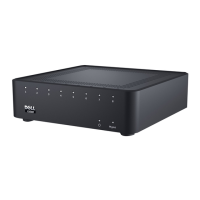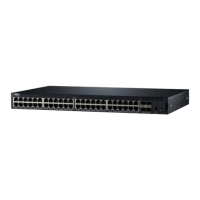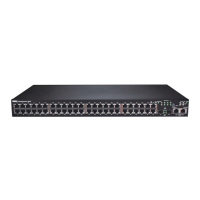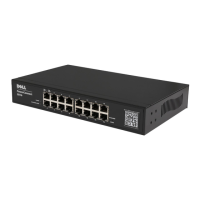Network Administration: Spanning Tree and LAG 195
FILE LOCATION: C:\Users\gina\Desktop\Checkout_new\Dell Astute\User
Guide\Dell_Astute_Network_Admin_STP.fm
DELL CONFIDENTIAL – PRELIMINARY 8/9/16 - FOR PROOF ONLY
–
Port State —
Displays whether the port is enabled or disabled in the
specific instance.
–
Type —
Displays whether MSTP treats the port as a point-to-point
port, or a port connected to a hub, and whether the port is internal to
the MST region or a boundary port. A Master port provides
connectivity from a MSTP region to the outlying CIST root. A
Boundary port attaches MST bridges to LAN in an outlying region. If
the port is a boundary port, it also indicates whether the device on the
other side of the link is working in RSTP or STP mode.
–
Role —
Displays the port role assigned by the STP algorithm in order
to provide to STP paths. The possible options are:
•
Root
— This port provides the lowest cost path to forward packets
to root switch.
•
Designated
— This port is the interface through which the bridge
is connected to the LAN, which provides the lowest cost path
from the LAN to the Root Bridge.
•
Alternate
— This port provides an alternate LAG to the root
switch from the root interface.
•
Backup
— This port provides a backup path to the designated
port. Backup ports occur only when two ports are connected in a
loop by a point-to-point link. Backup ports also occur when a LAN
has two or more connections connected to a shared segment.
•
Disabled
— This port is not participating in the Spanning Tree.
–
Interface Priority
—
Enter the interface priority for specified instance.
–
Path Cost
— Enter the port contribution to the Spanning Tree
instance. If a loop occurs, the spanning tree considers path cost when
selecting an interface to put in the Forwarding state or select
Use
Default
.
–
Designated Bridge ID —
Displays the bridge ID number that
connects the link or shared LAN to the root.
–
Designated Port ID —
Displays the Port ID number on the
designated bridge that connects the link or the shared LAN to the
root.
–
Designated Cost —
Displays the cost of the path from the link or the
shared LAN to the root.

